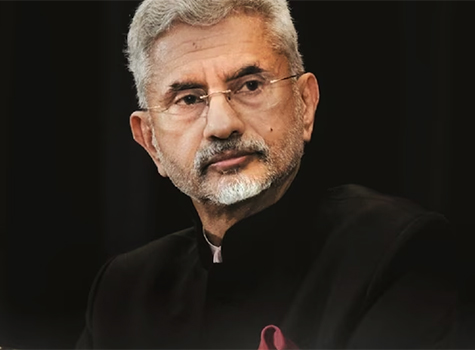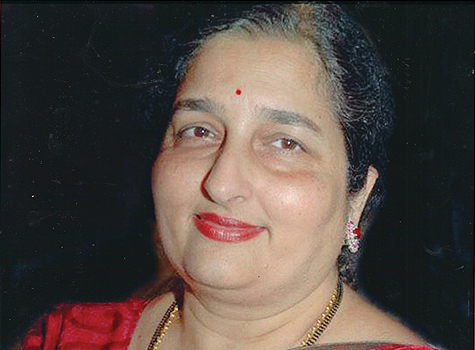By Girish Modi
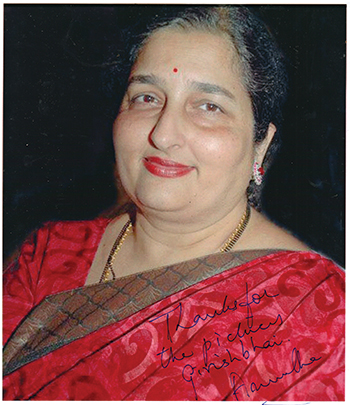 I had the honor of meeting Anuradha Paudwal twice over a 40-year period. I met her and her late husband Arun Paudwal in 1978 when they had come with Kishore Kumar on his first concert in the USA. She was only 24 years old at that time, but her voice was just like Lata Mangeshkar’s. I met her for the second time in 2015 when she performed at a Diwali concert in Cary, NC.
I had the honor of meeting Anuradha Paudwal twice over a 40-year period. I met her and her late husband Arun Paudwal in 1978 when they had come with Kishore Kumar on his first concert in the USA. She was only 24 years old at that time, but her voice was just like Lata Mangeshkar’s. I met her for the second time in 2015 when she performed at a Diwali concert in Cary, NC.
I was very impressed when she had sung the very difficult song “Rasik Balma” from Chori Chori as her maiden live performance in 1978. Many singers have tried to imitate Lataji’s voice; but Anuradha and Shreya Ghoshal are only two singers whose voices sound exactly like Lataji’s. As a matter of fact, when you listen to two versions of “Maine Jisko Dil diya Hai” duet from the film Muskaan, only an expert can distinguish Anuradha’s voice from Shreya’s voice. Years later when I mentioned it to Shreya Ghoshal, she was very impressed.
Very few people know that Anuradha’s maiden name was Alka Nadkarni. Her husband Arun changed her name to Anuradha after marrying her so that people would not confuse her with Alka Yagnik. She and Kumar Sanu used to participate in singing competitions when they were students at St. Xavier’s College in Mumbai. Anuradha was one of the most successful playback singers of the 80s and 90s era. She has recorded thousands of songs and more than 1,500 bhajans in several languages. She is often known as “Bhajan Queen” and “Melody Queen”.
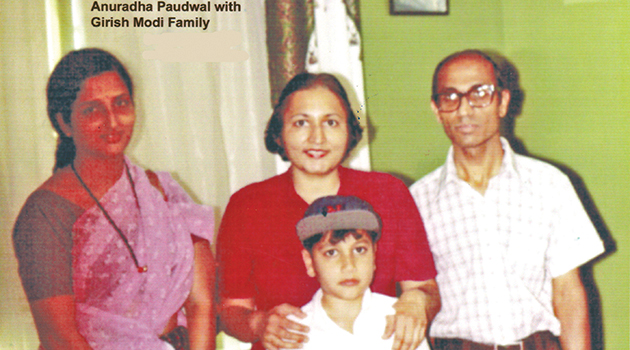 Anuradha was in fourth grade when a Lata song that she had heard on radio triggered off her interest in music. She attended a live recording of unreleased SD Burman composition sung by Lata, “Puchho Zara Kiske Liye Aayee Hoon,” with a friend who inspired her to sing. However, she had a hoarse voice, and classmates often called her a “peacock” in those days.
Anuradha was in fourth grade when a Lata song that she had heard on radio triggered off her interest in music. She attended a live recording of unreleased SD Burman composition sung by Lata, “Puchho Zara Kiske Liye Aayee Hoon,” with a friend who inspired her to sing. However, she had a hoarse voice, and classmates often called her a “peacock” in those days.
During a bout of pneumonia for which she was bed-ridden for more than 40 days, Anuradha listened to Lataji’s recording of Bhagwad Gita incessantly and when she recovered from the illness, her voice had changed. She took this miracle in stride and tried to mold her voice as she continued her autodidact from her spiritual guru — Lata Mangeshkar.
During a visit along with Arun to a Lata Mangeshkar recording composed by Hridaynath Mangeshkar, she was able to grasp the complete song and sang it live on a popular radio program, Yuva Vani. Several top composers including Hridaynath Mangeshkar and Laxmikant-Pyarelal called the radio station to seek the singer. When they learned that it was Arun’s wife, they offered to launch her career. But Anuradha, with her conservative background, was not ready to make the leap yet.
She made her debut from a Sanskrit verse in the 1973 Hindi film Abhiman. At that time, she used to sing as a dubbing artist. She obtained popularity from her song “Tu Mera Janu Hai” along with Manhar Udhas in the film Hero. She had been asked to ‘dub’ this song for Lata Mangeshkar. But when the music director, the duo Laxmikant-Pyarelal heard Anuradha’s version, they decided to keep it. She then recorded 23 songs composed by Nadeem-Shravan.
Ten songs out of them were released as the Chahat album, but the producer decided to include them as film songs in the Aashiqui movie in 1990. Aashiqui songs became so popular that it established Anuradha as a successful playback singer.
After the concert in 1978 I met with both Anuradha and Arun backstage and invited them to come to my home as guests, which they immediately accepted.
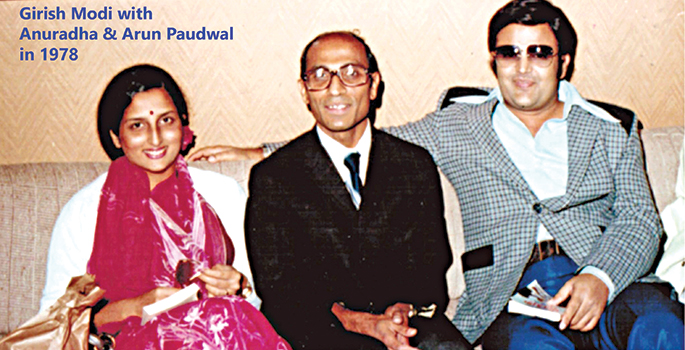 Arun had told me during his stay at my house that he had come as lead musician for Lataji’s first concert in U.S.A in 1976. Arun’s father had died while he was in America, still he stayed with the tour so that Lataji’s concert will not have to be cancelled. Anuradha was often given preference over the Mangeshkar sisters. I was told by Arun that Lataji had destroyed his career as assistant to S. D. Burman because she was jealous of Anuradha’s success and was forced to join Bappi Lahiri, a newcomer at that time. I was moved when tears rolled down on his cheeks, while recollecting.
Arun had told me during his stay at my house that he had come as lead musician for Lataji’s first concert in U.S.A in 1976. Arun’s father had died while he was in America, still he stayed with the tour so that Lataji’s concert will not have to be cancelled. Anuradha was often given preference over the Mangeshkar sisters. I was told by Arun that Lataji had destroyed his career as assistant to S. D. Burman because she was jealous of Anuradha’s success and was forced to join Bappi Lahiri, a newcomer at that time. I was moved when tears rolled down on his cheeks, while recollecting.
Anuradha was very quiet and helped my wife cook food for us. She also liked watching the Lucy Show on TV. My son was 7 years old at that time. Though both spoke in Gujarati with my wife and son, I found Anuradha’s pronunciation better than Arun’s. I took them to a music store in Manhattan, where Arun bought an expensive Moong synthesizer which was shipped directly to India to avoid paying sales tax. A month later I received a letter from Arun, wherein he had asked me to contact the music store for a copy of the invoice so that he could clear the synthesizer from customs.
A few years later when my son visited India for the first time, he was bragging about meeting Anuradha Paudwal and also Hema Malini because his dad was a famous photographer.
Anuradha ended her first innings in mainstream movie films abruptly when she was on the verge of claiming the throne of the likes of Lata Mangeshkar and Asha Bhosle. Afterwards she started singing devotional songs, which became very popular.
During her prime, legendary veteran composer OP Nayyar had said, “Lata is finished. Anuradha has replaced her.” By the time she reached this pinnacle, she had already been struggling for 17 years.
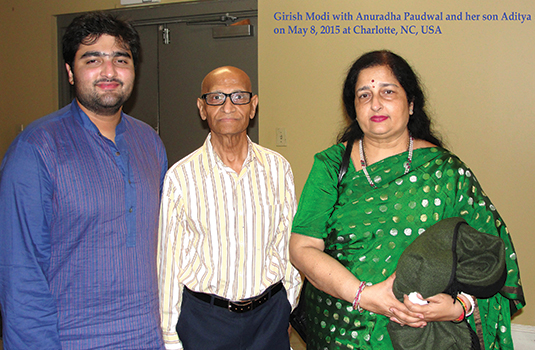 Anuradha came back after quitting for a few years and got some of the best songs and became popular again, but at that time Alka Yagnik was dominating the Industry and Anuradha Paudwal didn’t receive much success like she had achieved earlier. She continued to sing until 2006 and after that she quit Bollywood.
Anuradha came back after quitting for a few years and got some of the best songs and became popular again, but at that time Alka Yagnik was dominating the Industry and Anuradha Paudwal didn’t receive much success like she had achieved earlier. She continued to sing until 2006 and after that she quit Bollywood.
She has won four Filmfare Awards out of eleven nominations. She has also appeared in popular singing show Indian Idol as a special guest where she shared some of the memories of her career.
When Anuradha had come to Cary, NC for a Diwali concert in 2015, I had driven 430 miles each way alone to attend her concert, because nobody else wanted to go that far for the concert.
I had bought a first-row ticket and was allowed to take photos and videos by the organizers. I went on the stage during the interval, because Anuradha was sill sitting there instead of going back stage. I spoke to her about her and Arun visiting my home in 1978, which she did not remember. So, I showed her a few photographs from 1978, and she was very moved and almost cried. Though Aditya was a musician like his father, her daughter Kavita is a singer like her.
I don’t believe her daughter had accompanied Anuradha on her concert tour. Ironically, while Anuradha started her career singing Lataji’s songs, Kavita started her career singing Ashaji’s songs.
Aditya had come with Anuradha and was playing harmonium during the concert. After Anuradha introduced me to Aditya, I gave him photos of his parents taken in 1978 as mementoes. He thanked me and touched my feet by calling me uncle. Anuradha wrote a thank you note on the picture I asked her to sign.
I didn’t really enjoy the concert, because Anuradha sang only a few songs, and other local male singers were singing while she would go backstage to relax. I had noticed that she was sweating a lot and wiping her forehead often. After the concert I stayed on when Anuradha and Aditya were taken to the backroom where they had dinner. After dinner, she continued talking with me ignoring a few volunteers taking her pictures. I was elated when Anuradha and Aditya specially posed for a picture with me before going to the airport.
I left at midnight and drove back non-stop to Atlanta and reached there around 7am. Along the way I was savoring my meeting. Anuradha survived a helicopter crash in 2002 in Madhya Pradesh. Sadly, Arun died in 1991 at the age of 47 and Aditya died of kidney failure in 2020 at the age of 35.
Girish Modi is a retired engineer who is passionate about Indian music and classical dances. He donates money to various Indian organizations and provides free photo service. Contact: girish39@yahoo.com.

